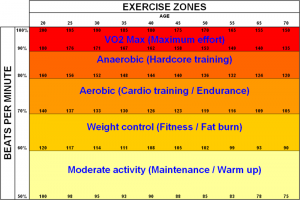Time to talk about all those heart rate charts. They are so neat and tidy, they make everything so simple and clear. We have seen them for so long that we dont even think about them or question them. If you want to lose weight, you put your heart rate in the “weight loss zone”, right? Well, maybe, maybe not!
The biggest problem of all with these pretty heart rate charts is that there is a HUGE variation in heartrates between similar healthy individuals which lowers the values of the charts right off the bat. First lets look at how these charts are made, they start with this formula:
HRmax = 220 – age
Then they typically make pretty zones based upon percentages of this calculated max.
- 90%-100% – Max
- 80%-90% – Anaerobic
- 70%-80% – Aerobic
- 60%-70% – Weight control
- 50%-60% – Warm up
So those pretty charts are all based upon a formula that only takes age into account and nothing else and then arbitrarily divide it up into pretty zones. Did you ever wonder what a complete coincidence it is that all the percentages are multiples of ten? I have never seen any research that shows that people who do cardio at precisely 60%-70% of their max lose weight but those who do cardio at 59% or 71% of their max do not :) I can guarantee you that the resting heart rate of a sedentary obese smoker is far, far higher than that of a marathon runner. Marathon runners often have resting heart rates as low as 40bpm whereas people in horrible shape can have resting heart rates as high as 100bpm. If there is that kind of variation when you are doing *nothing*, how much variation will there be when you actually start exercising?
Many people have this irrational fear of 100% heartrate. For tens of thousands of years cavemen were sprinting to catch their food. They had no idea what their heartrate was but it was at 100%, and they didnt die. Unless you have some underlying heart condition, you dont drop dead when your heart-o-meter gets pegged at 100%. Many folks these days seem to have an unwarranted fear of high effort cardio. If you have any fears about this, go to your doctor and get a physical, its a really good idea before starting any exercise program anyway! If you want peak athletic performance, you gotta peg your heart rate occasionally as part of your training – even for endurance athletes.
So if these charts are virtually useless, what CAN you do? What heartrate YOU should use when doing cardio? There are *many* different cardio training methods but again, it depends on what your GOAL is. You cant just say “X is the BEST cardio”, you have to say “X is the best technique for improving VO2 max” or something specific like that. Please read about cardio.
For serious sports and athletic training, the first step is always in measuring what 100% is for YOU. Then based on your 100% heartrate, you come up with five heart rate zones (just numbered, not named) and come up with a plan. Typically these serious cardio workouts specify the total duration of the cardio and how long you are in each heart rate zone.
Zone 5 is typically defined as 90%-100% of your max heart rate. Very few sports are optimally trained for by always pegging your heart rate in zone 5, OK, maybe very short sprint distances. When you train for endurance events like the Ironmans, you spend a lot of time in zone 2 (60%-70%), or zone 3 (70%-80%), but punctuate it with bursts of 100% zone 5 effort simulating hills. Basically, train for the race.
When training its often not possible to stop and measure your heart rate with a watch and with your finger on your pulse, swimming is a great example of where you cant do this. Heart rate monitors are expensive and many dont have them but you can do sophisticated cardio training with these simple three zones. Here are the two markers that divide the cardio zones:
- VT1 (Ventilation Threshold 1). Below VT1 you can talk completely normally. Above VT1, you can talk but you have to insert breathing pauses at un-natural points in your speech.
- VT2 (Ventilation Threshold 2) Above VT2 you can only speak one or two words(
For example, one way to do interval training is to sprint for 2 minutes of 100%, then to walk until you get down to VT1 and then sprint 2 minutes again. Of course, you can always do HIIT (interval training) based upon time rather than heart rates as well, this is what my Scoobervals workout does.
Whats the take home message?
There is no “best cardio”, it depends on your personal goals and limitations. The real world doesnt fit into pretty little graphics like the heart rate chart. The exercise chart is fine for newcomers to fitness but if you have any sports performance goals at all you need to be more scientific about measuring your max heart rate and zone training.

